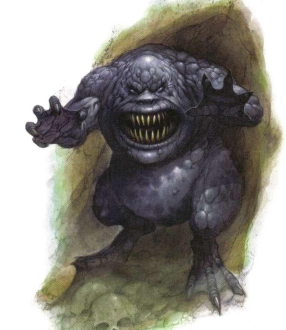Let's Read the 4e Monster Manual 2: Slaad
This article is part of a series! Click here to see the rest.
Slaads already made their 4e debut in the first Monster Manual, and you can check out the post I wrote on them here. This MM2 entry brings us a lower-level, less-popular slaad type and an alternate mechanic for the horrific slaad spawning cycle.
Flux Slaad

Flux slaads seem to be the runts of the slaad family. They’re weaker and stupider than their relatives, they can’t spawn, and their chaotic mutations are at best a mixed blessing. Still, being weaker actually means they might have an easier time slipping through a dimensional crack into the world, which they love because it allows them to lord it over creatures even weaker than them.
Flux slaads who slip into the world often end up conquering bullywug tribes and setting themselves up as their god-kings. Finding one of these on the throne instead of the usual “slightly stronger frog-dude” can be an interesting experience for cocky PCs.
The Numbers
Flux Slaads are Medium Elemental Humanoids, and Level 9 Skirmishers with 98 HP. They have low-light vision, a ground speed of 7, and a teleport speed of 2.
They fight with their claws. They can use those in a Flux Rage maneuver that allows them to shift 2 squares and attack everyone they pass by during this movement. This recharges when they’re first bloodied. When they take damage from an attack, they can shift 1 square as a reaction.
Nothing special so far, but now we come to the part that gives these slaads their names. Slaad Vulnerability Shift should really have a name that includes the word “flux” in it. This trait makes the slaad start out with random vulnerability determined by a d6 roll: (1) cold, (2) fire, (3) lightning, (4) necrotic, (5) psychic, (6) thunder. The slaad has Vulnerability 10 to that damage type, but Resistance 5 to all the other table entries. Every time the slaad takes damage from its current weakness, you roll the die again and determine a new weakness.
Slaad Spawn

Most slaads reproduce by infecting victims with a disease called Chaos Phage, which causes slad tadpoles to gestate within the victim’s flesh. The tadpole grows and eventually erupts from its host, running away to mature elsewhere. This was covered in the MM entry for Slaads.
A few of them are instead infected with a mutant strain of chaos phage, which produces embryos in their own flesh. These slaads are covered in gross giant boils that pop when they’re wounded, spawning miniature versions of themselves. These spawn are both almost mindless and extremely aggressive, so they often get used as weapons by their “parents”. Should they survive the circumstances of their birth, the spawn develop quickly and begin exhibiting powers similar to those of an adult within days.
The Numbers
Spawn are Small Elemental Humanoids, and Level 17 Minion Skirmishers. They have low-light vision, a running speed of 5, and a teleport speed of 3. They attack with bites and can also pounce using a Chaotic Slam. On a hit, they damage and knock down the target. On a miss, they explode, dealing a bit of damage in a Close Burst 1.
We also get stats for an elite template named Slaad Spawner, which can be applied to any Large-sized regular slaad. This is turns the slaad into an elite monster, and adds a Spawn Slaad reaction power that creates a new slaad spawn whenever the spawner is hit by an attack. The new spawn appears adjacent to the spawner, and acts right after the spawner’s action. The template is unusual in that it doesn’t add additional HP to the regular monster. It does bring a new minion into play every round, so maybe they thought this was enough to make up for their lower HP. The spawner is worth double the experience of the original slaad, but the spawned minions aren’t worth any.
Sample Encounters and Final Impressions
The flux slaad is kinda meh aside from its “weakness roulette” mechanic. The roulette is interesting, but your party needs a lot of damage types (or a lot of lucky d6 rolls) to keep it spinning. Otherwise it’s going to stop on a type they can’t use, which means the slaad becomes resistant to the types they can. At least you can always beat it up using physical damage, which means martial types can end up being more effective against it than the casters.
Perhaps you could build a “puzzle boss” that had the same mechanic, plus some way for the party to influence the result of the d6 roll.
Slaad spawn and the Spawner template bring another flavor of body horror to a slaad fight. Since it seems spawn mature even faster than tadpoles, a spawner presents an even nastier apocalyptic scenario than a normal slaad. It also presents the GM with an excuse to throw lots of de-leveled slaads against a heroic tier party, since those could be “immature” slaads that have grown past the spawn stage but not developer all the way yet.
Our two sample encounters are:
-
Level 8: A death shard, 3 flux slaads, and 2 slaad tadpoles. Likely brought to the world by a small Elemental or Abyssal rift.
-
Level 17: 2 blue slaads, 1 green slaad, 8 slaad spawn. The blues and green are likely minding their little siblings and doing a typical slaad job of it. Note that the spawn are worth XP in this encounter, since they’re not “produced” by an on-site spawner.